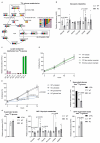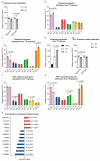Altered Cellular Metabolism Is a Consequence of Loss of the Ataxia-Linked Protein Sacsin
- PMID: 39769008
- PMCID: PMC11675909
- DOI: 10.3390/ijms252413242
Altered Cellular Metabolism Is a Consequence of Loss of the Ataxia-Linked Protein Sacsin
Abstract
Mitochondrial dysfunction is implicated in the pathogenesis of the neurological condition autosomal recessive spastic ataxia of Charlevoix-Saguenay (ARSACS), yet precisely how the mitochondrial metabolism is affected is unknown. Thus, to better understand changes in the mitochondrial metabolism caused by loss of the sacsin protein (encoded by the SACS gene, which is mutated in ARSACS), we performed mass spectrometry-based tracer analysis, with both glucose- and glutamine-traced carbon. Comparing the metabolite profiles between wild-type and sacsin-knockout cell lines revealed increased reliance on aerobic glycolysis in sacsin-deficient cells, as evidenced by the increase in lactate and reduction of glucose. Moreover, sacsin knockout cells differentiated towards a neuronal phenotype had increased levels of tricarboxylic acid cycle metabolites relative to the controls. We also observed disruption in the glutaminolysis pathway in differentiated and undifferentiated cells in the absence of sacsin. In conclusion, this work demonstrates consequences for cellular metabolism associated with a loss of sacsin, which may be relevant to ARSACS.
Keywords: ARSACS; aerobic glycolysis; metabolism; mitochondria; sacsin.
Conflict of interest statement
The authors declare no conflicts of interest.
Figures





Similar articles
-
A reduction in Drp1-mediated fission compromises mitochondrial health in autosomal recessive spastic ataxia of Charlevoix Saguenay.Hum Mol Genet. 2016 Aug 1;25(15):3232-3244. doi: 10.1093/hmg/ddw173. Epub 2016 Jun 10. Hum Mol Genet. 2016. PMID: 27288452 Free PMC article.
-
Mitochondrial dysfunction and Purkinje cell loss in autosomal recessive spastic ataxia of Charlevoix-Saguenay (ARSACS).Proc Natl Acad Sci U S A. 2012 Jan 31;109(5):1661-6. doi: 10.1073/pnas.1113166109. Epub 2012 Jan 17. Proc Natl Acad Sci U S A. 2012. PMID: 22307627 Free PMC article.
-
S100B Mitigates Cytoskeletal and Mitochondrial Alterations in a Glial Cell Model of Autosomal Recessive Spastic Ataxia of Charlevoix-Saguenay.Mol Neurobiol. 2025 Sep;62(9):12296-12306. doi: 10.1007/s12035-025-05057-3. Epub 2025 May 19. Mol Neurobiol. 2025. PMID: 40389788 Free PMC article.
-
Genetics of Autosomal Recessive Spastic Ataxia of Charlevoix-Saguenay (ARSACS) and Role of Sacsin in Neurodegeneration.Int J Mol Sci. 2022 Jan 4;23(1):552. doi: 10.3390/ijms23010552. Int J Mol Sci. 2022. PMID: 35008978 Free PMC article. Review.
-
Insights into SACS pathological attributes in autosomal recessive spastic ataxia of Charlevoix-Saguenay (ARSACS)☆.Curr Opin Chem Biol. 2022 Dec;71:102211. doi: 10.1016/j.cbpa.2022.102211. Epub 2022 Sep 17. Curr Opin Chem Biol. 2022. PMID: 36126381 Review.
References
-
- Engert J.C., Bérubé P., Mercier J., Doré C., Lepage P., Ge B., Bouchard J.-P., Mathieu J., Melançon S.B., Schalling M., et al. ARSACS, a spastic ataxia common in northeastern Québec, is caused by mutations in a new gene encoding an 11.5-kb ORF. Nat. Genet. 2000;24:120–125. doi: 10.1038/72769. - DOI - PubMed
-
- Parfitt D.A., Michael G.J., Vermeulen E.G., Prodromou N.V., Webb T.R., Gallo J.-M., Cheetham M.E., Nicoll W.S., Blatch G.L., Chapple J.P. The ataxia protein sacsin is a functional co-chaperone that protects against polyglutamine-expanded ataxin-1. Hum. Mol. Genet. 2009;18:1556–1565. doi: 10.1093/hmg/ddp067. - DOI - PMC - PubMed
-
- Bradshaw T.Y., Romano L.E.L., Duncan E.J., Nethisinghe S., Abeti R., Michael G.J., Giunti P., Vermeer S., Chapple J.P. A reduction in Drp1-mediated fission compromises mitochondrial health in autosomal recessive spastic ataxia of Charlevoix Saguenay. Hum. Mol. Genet. 2016;25:3232–3244. doi: 10.1093/hmg/ddw173. - DOI - PMC - PubMed
-
- Girard M., Larivière R., Parfitt D.A., Deane E.C., Gaudet R., Nossova N., Blondeau F., Prenosil G., Vermeulen E.G.M., Duchen M.R., et al. Mitochondrial dysfunction and Purkinje cell loss in autosomal recessive spastic ataxia of Charlevoix-Saguenay (ARSACS) Proc. Natl. Acad. Sci. USA. 2012;109:1661–1666. doi: 10.1073/pnas.1113166109. - DOI - PMC - PubMed
MeSH terms
Substances
Supplementary concepts
Grants and funding
LinkOut - more resources
Full Text Sources
Medical

